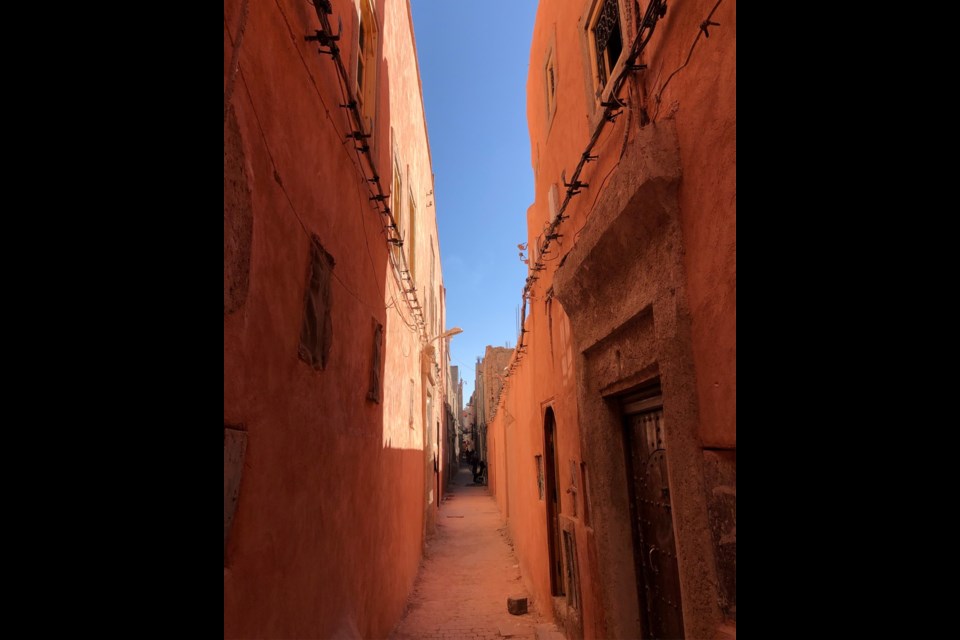Our adventures began in the Casablanca airport parking lot. The Economy car rental attendant offered a weathered SUV and assured my husband and I, "C'est une excellent voiture." French is spoken by most in this Arab-Berber kingdom. We were somewhat reluctant, but eventually acquiesced, figuring we'd blend in like locals with a used vehicle covered in desert sand, and I even donned a hijab.
The 100 windy kilometres of bucolic spring green farmlands peppered with shepherds herding their goats and sheep to El Jadida was breathtaking. Restaurant du Port overlooked the 16th-century Portuguese stonewall Atlantic harbour that was packed with blue, wooden fishing boats. As we savoured our fresh sole lunch, a visitor joined us—a ginger-coloured kitten, which we soon discovered is a common Moroccan sight.
Essaouira is 275 kilometres south of El Jadida, and we encountered some treacherous washed-out spots along the coastal road. With an azure sky and gilded ocean views, we didn't mind the challenge and neither did our seasoned SUV.
Villa Maroc, a riad nestled in Essaouira's European inspired medina, is a picturesque family-run guesthouse, restaurant, bar, and hamman. Our room overlooked the misty beach, popular amongst surfers. Famished and fatigued, we snuggled up by a romantic fire in one of the restaurant's private stucco rooms, and were served a scrumptious turmeric beef couscous paired with Perle Noire, a local red.
We roused to the early call to mosque salat (prayer). Blooming germaniums, blue mosaic tables, and seafoam green chairs filled the ocean rampart view roof deck. Fatima, an attendant since 1990, served us a delicious breakfast that included fresh flat bread and locally made preserves.
The caramel-coloured sand beach beckoned us where hopeful camel hagglers offered rides. We continued on to the dock with a bustling fish market filled with sardines, snapper, and shellfish. Jetlagged, we returned to Villa Maroc's hamman, and bathed with black soap, an olive paste soap known for its moisturizing qualities.
Before dinner, copious cats greeted us, as we meandered hand-in-hand through the medina. We eyed an ivory-beige, diamond-patterned rug perfect for our living room, but not quite the size we needed. Mohammad, the Maison Berbere merchant, assured us that it could be customized in the time it took to eat Villa Maroc's lobster and aubergine dinner.
Late morning, we began the 170-kilometre Marrakech journey with our Beni Ourain rug breezing through the argan tree farms. Goats climb argan trees and eat the fruit, which is collected from their droppings, aiding the arduous process of producing a magical oil sought after by chefs and aestheticians.
Travel the speed limit. We were stopped by police three times, who were especially friendly when we paid the 400-dirham ticket in cash.
La Mamoumia, a palatial kingdom within itself, is near the Koutoubia Minaret and the north gate of Marrakech's mystical medina. After checking in, we headed to the enchanted-garden swimming pool to catch the last rays of the day. No hijab needed. Dinner at La Morocain was exquisite. The orange orchard entrance with the velvet and toutaoui design details made us feel like sultans.
The next day, we explored the medina souks infused with aromatic spices, leather goods and pottery that led us to the mellah, Jewish quarter. The Lazama synagogue, built in 1492 during the Spanish Inquisition, is hidden within the mudbrick alleyways.
At sunset in the Agafay Desert, 35 kilometres southwest of Marrakech, we celebrated our 20th anniversary with champagne and succulent chicken tagine gazing upon the snowcapped High Atlas Mountains. We sipped hot mint tea by a blazing olive-wood fire beneath the half-moon, star-filled sky, while we were serenaded by gimbari and drum musicians.
The next day, we wandered to the Yves Saint Laurent (YSL) Museum, a fashionistas delight archiving his Moroccan influenced designs. YSL purchased the adjacent botanical oasis, Majorelle Garden, in 1980, and the Berber Museum within the grounds was worth maneuvering the crowds for.
Our last day, we ascended to Asni, a serene Berber village carved in the hillside of the High Atlas Mountains 75 kilometres from Marrakech. Rashid, a local guide, led us through the rock-cliff trails with scenic views of olive and walnut orchards, riverbeds, and mountain vistas. It was unusually warm, and the peach trees were already in bloom.
In the evening, Marrakech's bustling square, Jemaa el-Fnaa, beckoned us. We slithered through macaque monkeys, henna artists and fragrant food stalls. Deep within the souks we stumbled upon a restored 16th-century enchantment, Dar Cherfa, where we dined by reflective pools, decorative auburn stucco, and tiles.
It was time to say au revoir. As we shared the Casablanca-Marrakech motorway with donkey-drawn carts, motorcycles, and trucks, we were mesmerized once again by the juxtaposition of the ancient and modern magique of Morocco—and grateful that our SUV had weathered our memorable journey.




